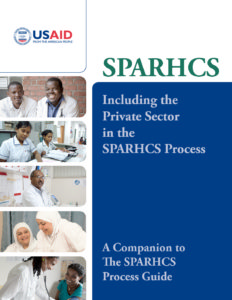Abstract
Many countries are now facing resource and programmatic challenges created by growing populations of women of reproductive age, increasing use of contraceptives for family planning, still substantial unmet need, and growing response to the HIV/AIDS pandemic. Chief among these challenges is the need to maintain a consistent, accessible supply of high quality contraceptives and condoms and family planning/reproductive health services sufficient to satisfy the increasing demand. Meeting this challenge has been made more difficult in many countries by limited public resources available for reproductive health and by diminished or shifting international donor support.
SPARHCS – Strategic Pathway to Reproductive Health Commodity Security, is a tool created in 2004 to help country program planners and managers successfully meet the challenges of increased demand and limited resources through development and implementation of strategies for securing and maintaining the supplies essential to family planning and reproductive health services delivery. The SPARHCS process has been designed to bring together a wide range of stakeholders from within the public, private/nonprofit, and private/commercial sectors—each with its own set of capabilities and resources—to work together toward the goal of reproductive health commodity security (RHCS).
Country experience to date with the SPARHCS process has been largely successful. It has become clear, however, that it is sometimes difficult to effectively involve the anticipated wide range of stakeholders. In particular, it has sometimes proved difficult for public sector leaders in family planning and reproductive health to engage a variety of private sector stakeholders in the SPARHCS process. Without adequate inclusion of the financial and service delivery resources of the private/nonprofit and private/commercial sectors, strategies for creating and maintaining RHCS become more difficult to implement and may have diminished opportunities for success.
Public sector family planning and reproductive health program planners and managers cannot, therefore, afford to leave the considerable human and financial resources that the private/nonprofit and private/commercial sectors represent less than optimally involved in the RHCS process. This is a companion to The SPARHCS Process Guide, published in 2008 to aid RHCS planners in engaging public sector stakeholders. It seeks to provide guidance to RHCS planners in how best to involve a wide range of private sector stakeholders in the SPARHCS process and thus gain their partnership with the public sector in ensuring a consistent, accessible supply of high quality contraceptives and condoms and family planning/ reproductive health services for all those who need and want them.



